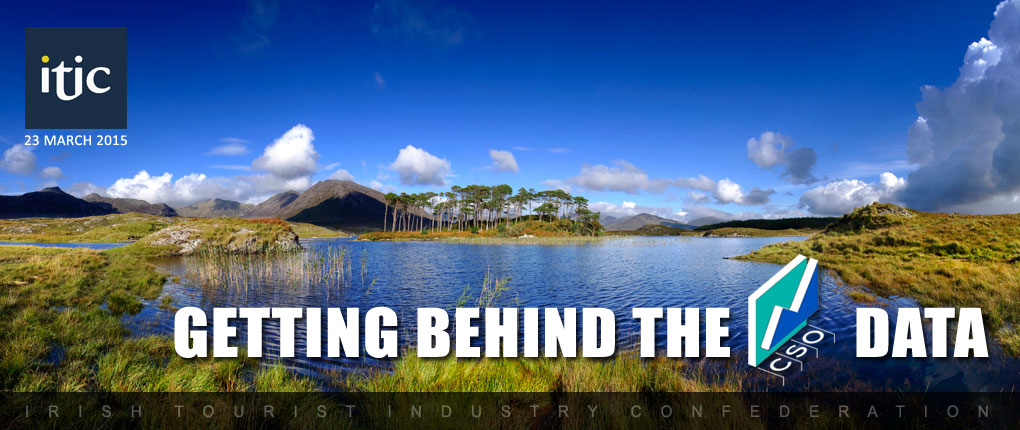
Mainland Europe continued to be the largest source of holiday/leisure visits accounting for just over 40% of the total by volume. Britain is the next largest source of holiday visitors accounting for 30% of the total, followed by North America at 24% and rest of the world at 6%.
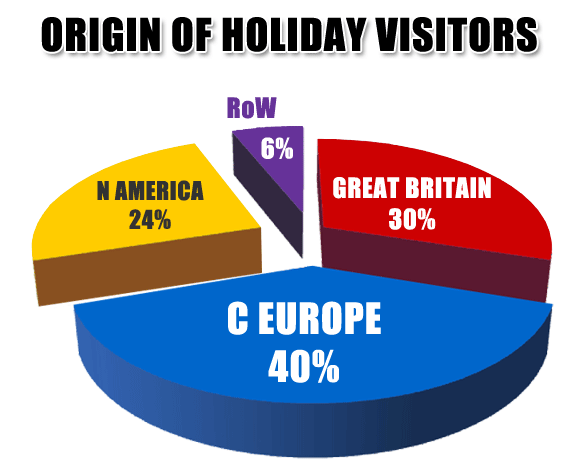
Within mainland Europe Germany is the top source market, accounting for 10% of all holiday visits to Ireland, followed by France the source of 8% of the demand.
2014 saw only marginal change in the relative importance of source markets for holiday visits, as growth in demand from North America outpaced the rate of growth from other markets. Over the period since 2008, mainland Europe and long haul markets have increased in importance as Britain declined in absolute and relative importance.
Holiday Visitors x Source Market 2008 & 2014 |
| |
2008 |
2014 |
% change
v 2013 |
% change
v 2008 |
| Britain |
1,572,000 |
978,000 |
+8% |
-38% |
| Mainland Europe |
1,196,000 |
1,304,000 |
+8% |
+9% |
| North America |
596,000 |
783,000 |
+13% |
+31% |
| Rest of World |
161,000 |
196,000 |
-6% |
+22% |
VFR DEMAND
Britain is the source of almost 3 out of every five VFR visitors – an estimated 1,254,000 in 2014 or 58% of all visits for this purpose. Mainland Europe has been an increasing as a source of VFR demand in over the past decade, reflecting migration patterns, and is now the source of 26% of VFR visits, or just over half a million visits. An estimated 350,000 visits to friends and relative originated from long haul source markets in 2014. It would appear that the number of VFR visits from mainland Europe grew by more than 10% last year, while demand from the long haul markets outside North America was also buoyant although small in volume.
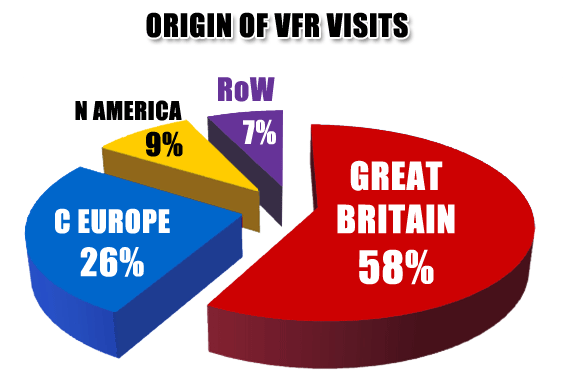
BUSINESS VISITORS
It would appear that the number of British business staying visitors dipped in 2014, while business trips from mainland Europe showed growth with demand from long haul markets largely unchanged. Britain accounts for just under half of all business visitors – 48% or an estimated 520,000 last year. Mainland European business visitors increased in relative importance to 38% share, followed by long haul markets the source of 14% of the demand.
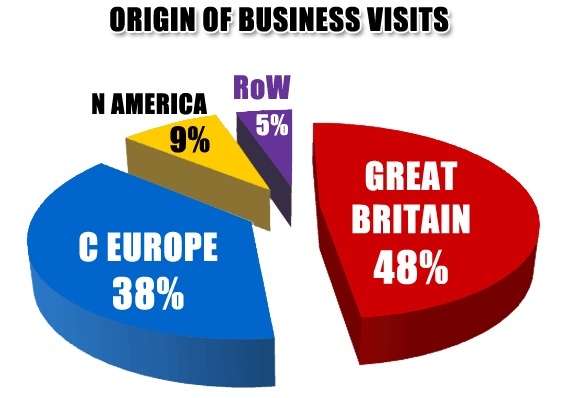


Overseas visitors spent a total of almost 55 million nights in Ireland in 2014, an 8% increase on the previous year.
Mainland European visitors generated 44% of total bednight demand, with just over 24 million nights, followed by British visitors accounting for 26% or 14.3 million. Long-haul markets of North America generated 9.8 million bednights with visitors from other long-haul markets spending 6.6 million nights in the country.
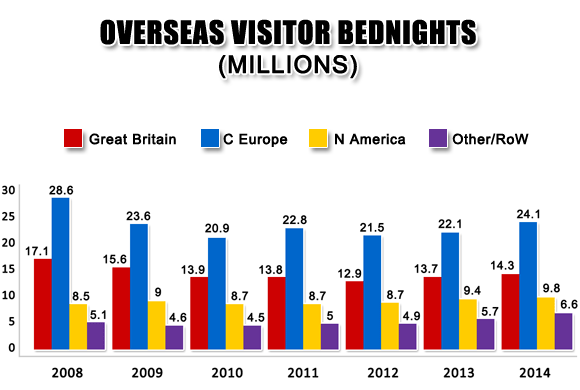
Source: CSO
Holiday visitors accounted for 40% of bednights in 2014, with VFR accounting for 30%, business 13% and those visiting for ‘other reasons’ 17%.
Bednights from VFR visits grew faster (+12%) than either the increase in bednights from holiday or business visits (each at close to +7%). This reflects the higher growth rate in VFR visits last year – the segment of the market with typically longest stays.
Where did they stay?
It would appear that all accommodation categories, other than hotels, enjoyed double digit increases in bednight demand from overseas visitors in 2014.
Paid serviced accommodations (Hotels, Guesthouses, and B&Bs) catered to 36% of the demand, while 29% of bednights were spent with friends and relatives at 29%. Rented accommodation commanded a 14% share of bednights, with a further 20% spent in other forms of accommodation.
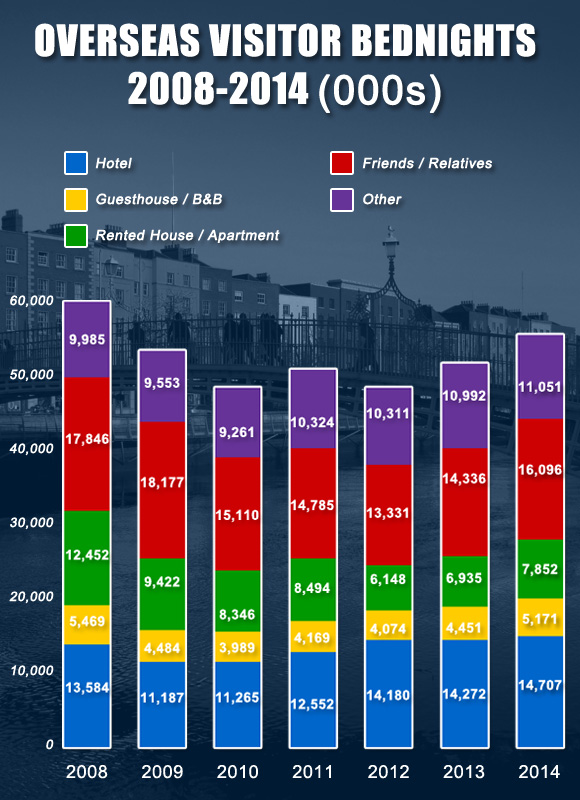
Source: CSO
Aggregated demand for hotels increased by 3% compared to a year earlier to reach an estimated 14.7 million bednights. Demand from North America was up 7% and from Britain up 4%, but with no increase from mainland Europe its largest volume overseas source market. Demand for hotels was particularly sluggish from the holiday sector (+2%), which accounts for two thirds of its overseas demand. Hotels' share of demand slipped 1 percentage point to 27% of total bednights in 2014.
Source of Hotel Bednight Demand 2013 & 2014 |
| |
2013 |
2014 |
| Mainland Europe |
39% |
38% |
| North America |
29% |
30% |
| Britain |
24% |
24% |
| Rest of World |
8% |
8% |
Guesthouses and B&Bs saw overseas demand increase by 16% in 2014 to an estimated 5.2 million bednights. The sector saw double digit growth from mainland Europe and North America combined with single digit increases from Britain and the Rest of the World. The increase in demand was noticeable across all purpose of visit segments.
Rented accommodation experienced a 13% increase in the number of bednights from overseas visitors, to reach 7.8 million, representing a 14% share. Demand from holiday visits increase by 28%, with demand from those visiting for ‘other reasons’, its largest source of demand, up 16%. Mainland Europeans account for close to 60% of demand for rented accommodation.
Unfortunately the CSO does not provide any analysis of visitation patterns across the regions or distribution of bednights by region. However, based on other data sources and anecdotal evidence it is safe to assume that the pattern of demand for categories of accommodation varies between Dublin, other major tourism hubs, and the rest of the country. Hence the aggregate national picture provided above will not necessarily reflect the experience in many parts of the country.

|
